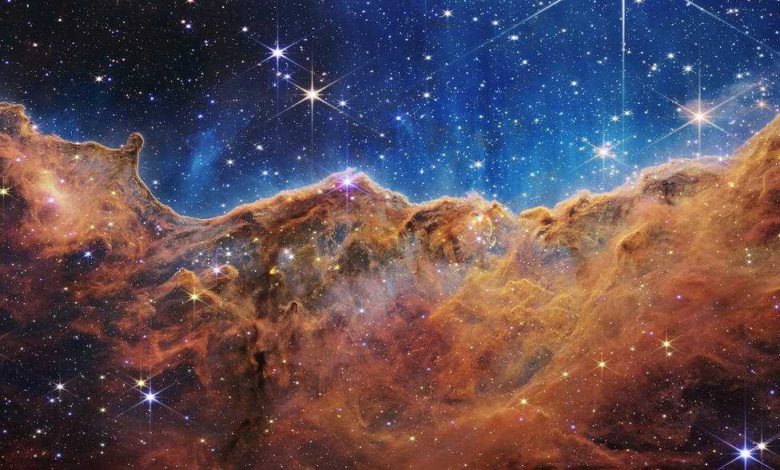

This week NASA released images from a new space telescope that has helped to expand our view of the universe. Anton Koekemoer with the Space Telescope Science Institute helped to put together different exposures from the James Webb Space Telescope that were released Monday and Tuesday. Watch the videos below to see him explain what we're seeing:PHOTO 1: The first photo that was released Monday shows a cluster of galaxies, Koekemoer said. "These are all the white galaxies in the foreground of this image, and they are actually quite distant. As it is, on the day of, the light has been traveling from this cluster of galaxies for a few billion years," he said.Koekemoer added that because the clusters are so massive, it’s sitting in what’s called a dark matter halo. "It's even more massive than the light we can see. And all of this mass is actually bending the light from more distant galaxies behind it," he said.PHOTO 2: Koekemoer said another photo explains the atmospheric composition of a hot gas giant exoplanet that has the chemical signature for water molecules. In this case, measurements provided by the Webb telescope showed the presence of steamy water vapors. He explained how scientists look at the starlight that is blocked as the planet passes in front of the star for insights. “As the light passes through the atmosphere, these steam molecules … absorb the light. So you see these dips in the spectrum that correspond to different molecular bands, basically of these water molecules.” He said this is a “very difficult, challenging observation to make.”PHOTO 3:Koekemoer said another photo shows what happens when “unstable” stars are at the end of their life and gas expands away from the star. “This whole ring of gas has basically been rejected by the star,” he said of the image.PHOTO 4:The Stephan’s Quintet group of galaxies are close together and gravitationally bound to each other, he said. With Webb, you can see the outflow of gas from the black hole, he said. “Up until now we’ve only been able to study this kind of process in the very local galaxies very close to our Milky Way,” he said. “Now we can begin to study this for distant black holes in the distant universe and try to understand how these black holes are formed, how the gas falls into them and how they grow.”PHOTO 5:Another image shows a cloud of gas in our Milky Way galaxy.“This whole region is part of a much larger ring of star formation,” he said. “And we’re looking at a tiny piece of that.” He said a star outside of the image is “lighting up this whole landscape.” The orange and rust-colored gas are dense clouds of “very cold molecular gas and dust,” he said.
This week NASA released images from a new space telescope that has helped to expand our view of the universe.
Anton Koekemoer with the Space Telescope Science Institute helped to put together different exposures from the James Webb Space Telescope that were released Monday and Tuesday.
Watch the videos below to see him explain what we're seeing:
PHOTO 1:
The first photo that was released Monday shows a cluster of galaxies, Koekemoer said.
"These are all the white galaxies in the foreground of this image, and they are actually quite distant. As it is, on the day of, the light has been traveling from this cluster of galaxies for a few billion years," he said.
Koekemoer added that because the clusters are so massive, it’s sitting in what’s called a dark matter halo.
"It's even more massive than the light we can see. And all of this mass is actually bending the light from more distant galaxies behind it," he said.
PHOTO 2:
Koekemoer said another photo explains the atmospheric composition of a hot gas giant exoplanet that has the chemical signature for water molecules.
In this case, measurements provided by the Webb telescope showed the presence of steamy water vapors.
He explained how scientists look at the starlight that is blocked as the planet passes in front of the star for insights.
“As the light passes through the atmosphere, these steam molecules … absorb the light. So you see these dips in the spectrum that correspond to different molecular bands, basically of these water molecules.”
He said this is a “very difficult, challenging observation to make.”
PHOTO 3:
Koekemoer said another photo shows what happens when “unstable” stars are at the end of their life and gas expands away from the star.
“This whole ring of gas has basically been rejected by the star,” he said of the image.
PHOTO 4:
The Stephan’s Quintet group of galaxies are close together and gravitationally bound to each other, he said.
With Webb, you can see the outflow of gas from the black hole, he said.
“Up until now we’ve only been able to study this kind of process in the very local galaxies very close to our Milky Way,” he said. “Now we can begin to study this for distant black holes in the distant universe and try to understand how these black holes are formed, how the gas falls into them and how they grow.”
PHOTO 5:
Another image shows a cloud of gas in our Milky Way galaxy.
“This whole region is part of a much larger ring of star formation,” he said. “And we’re looking at a tiny piece of that.”
He said a star outside of the image is “lighting up this whole landscape.”
The orange and rust-colored gas are dense clouds of “very cold molecular gas and dust,” he said.
Source link






